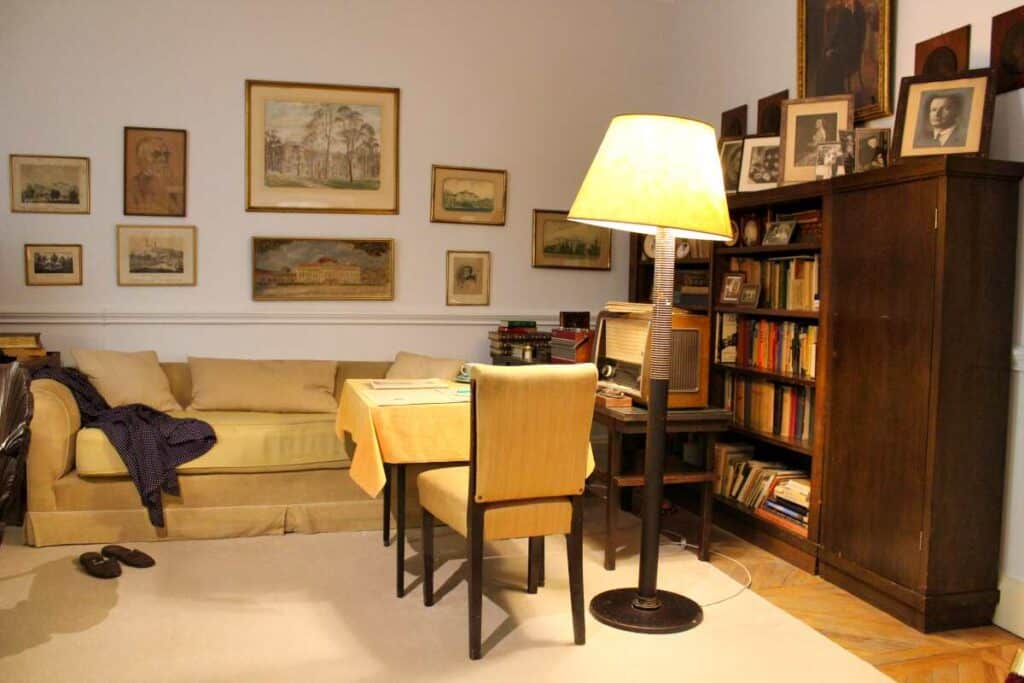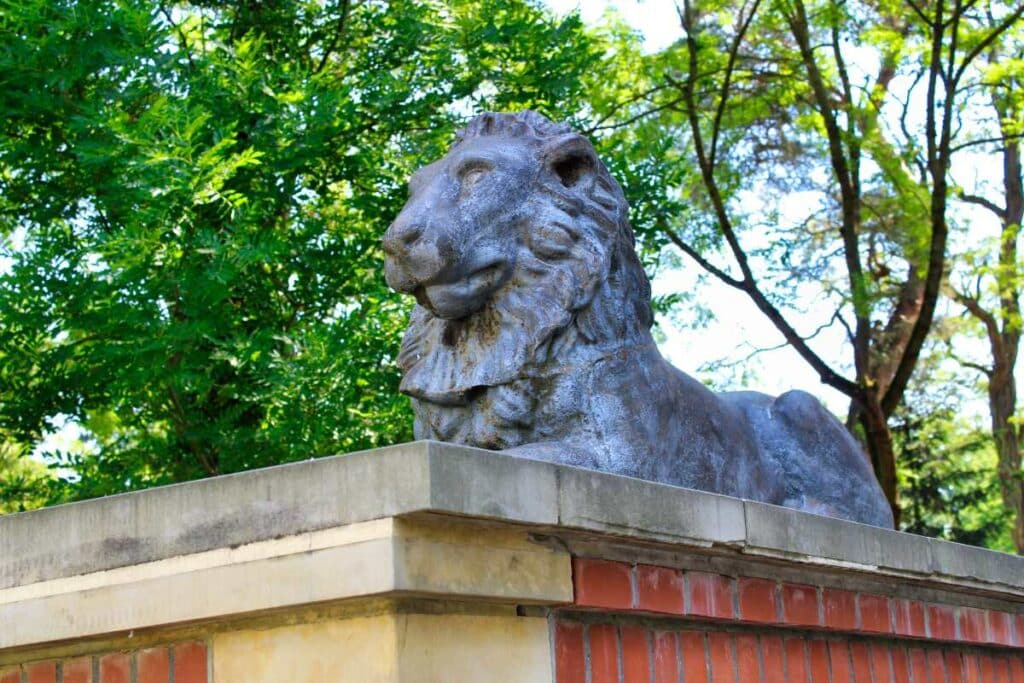About 20 km south of Poznan, in the heart of Wielkopolska, lays the small village Rogalin, which today has less than 1000 inhabitants. Nevertheless, thousands and thousands of visitors flock here year after year. The reason for this is the famous Rogalin Palace, once inhabited by the Raczyński family. Besides the palace, there is more to see, including the place where, according to legend, the Polish state was born. Reasons enough to introduce you to Rogalin Palace and its surroundings.
The Raczyński family
The Raczyński clan was one of the most influential Polish magnate families and part of the nobility, the so-called szlachta. According to legend, the lineage goes back to a knight who served in the army of Mieszko I, the first ruler of Poland. The family was part of the Nałęcz heraldic community, whose symbol, a knotted cloth, also adorns the family coat of arms. You will encounter it at every turn during your visit to Rogalin Palace. The Raczyńskis originally came from Wieluń near Łódź, but later a Wielkopolska branch was formed.

Kazimierz Raczyński came precisely from this branch. He acquired the modest village of Rogalin in 1766 and made the place the ancestral seat of his family and commissioned the magnificent Rogalin Palace, which was ready for living as early as 1774. Under his descendants the estate was then expanded and rebuilt several times. Although representatives of the family are still alive today, the last owner was Edward Raczyński (see below), who bequeathed it to the Polish people, which is why it can be visited today.

The history of Rogalin Palace
After Kazimierz Raczyński built the castle, it served as the family seat for six generations. In the early 1770s, at the same time as Rogalin Palace, the beautiful park, described below, was also created. The basic structure of the palace (a main building with two quarter-circle wings) was retained by the following generations. Early on, the actually Baroque palace was partially remodeled in the style of Rococo and Classicism, so that today one cannot speak of a uniform style.
The complex underwent a significant reconstruction in the 19th century, when Edward Raczyński (Kazimierz’s grandson) had the mausoleum and the landscape park built, and later the avenue consisting of chestnut trees was added. Edward is also to thank for the Armory, the only neo-Gothic room in the castle (see below). In any case, Edward can be considered one of the most important lords of the castle, because he was a great patron and promoter of the arts, in Poznan, for example, he donated the first public library in the region. His brother Atanazy, on the other hand, formed the basis of today’s National Museum with his collection.
The palace survived the Second World War also because the Hitler Youth maintained a school here. Later, the estate was initially empty, then in 1949 a museum was established here. After the fall of communism and the death of Edward Raczyński, an some careful renovation, the property was restored to the face of the 1930s, which is why today when you visit you almost feel like you did in those years.

Rogalin Palace
Rogalin Palace, part of the Poznan National Museum, is easy to visit today, with individual tickets available for all of the areas described below. For the palace itself (but not for the picture gallery) you have to keep in mind that there is a time window due to the large crowds. So if you have some time before the entrance, you can visit any part of the complex beforehand to pass the time.

The castle tour
In the palace (and only there) you will receive an audio guide (available in several languages), which will lead you through the individual rooms. You can visit numerous magnificent parts of the building and enjoy Delft tiles, old fireplaces, beautifully decorated mirrors, Brussels tapestries and a library that seems to be made entirely of wood and is one of the most beautiful rooms in the entire region. During your tour (which takes about an hour), you’ll come across paintings and many small details, such as chandeliers designed by Friedrich Schinkel.

You can also see a room where the wallpaper seems to blend seamlessly into the curtain. Along the way, you’ll have great views of the French landscape park, a visit to which is also one of the highlights of Rogalin Palace.

The carriage house
To the east of Rogalin Palace there is a complex that today includes a restaurant and the former carriage house. Here you can admire an impressive collection of historical carriages, dating from different centuries. Even sleighs and sedan chairs can be seen, as well as travel accessories and horse harnesses. A wooden carriage house was built immediately after the completion of Rogalin Palace and was replaced by a brick building as early as 1801.

The painting gallery
One of the absolute highlights of Rogalin Palace is its painting gallery. It goes back to Edward Aleksander Raczyński, who was able to acquire over 500 contemporary works of art in the period from 1880. In 1910, a gallery designed by Mieczysław Powidzki was built for the collection underneath the south wing of Rogalin Palace, which excellently accentuates the paintings shown here due to the natural light coming through the ceiling. Mainly representatives of Symbolism, Impressionism and Post-Impressionism can be seen here. Among the most outstanding works are certainly pastels by Stanisław Wyspiański, paintings by Józef Mehoffer and, first and foremost, the painting “Joan of Arc” by Jan Matejko from 1886.

The Maid of Orleans – A painting as big as a two-room apartment
You can’t miss it, because with a size of an incredible 47 square meters, it’s not only the largest painting by the famous historical painter, but also one of the largest in the entire country. When you approach it, you will notice how detailed Matejko worked, who also received help from his school of painting, because such a project would hardly have been possible alone. In view of the size of the Maid of Orleans, the painting by the well-known Matejko student Jacek Malczewski almost disappears next to it.

The ancestral gallery
A wing of the building in the north of the palace houses the Ancestral Gallery and the London Cabinet. Here, countless paintings from different eras are housed in one corridor. Just a glance at the names shows how well connected the family was and that there were also many dynastic connections to German noble families.

The London Cabinet
Edward Raczyński (not to be confused with the 19th century lord of the castle of the same name) spent 26 years in exile in London, where he lived at 8, Lennox Gardens. Thankfully, the family donated the furnishings of that apartment to the National Museum, which had them faithfully recreated here. Raczyński lived in the apartment when he was the head of state of the Polish government in exile from 1979 to 1986.
The eloquent last representative of his family died almost blind in London in 1993 at the age of 101 and bequeathed the castle to the Polish people. From the apartment you can get an idea of how modestly he lived despite his noble origins, everything looks as if he just went for a walk outside.

The mausoleum
Just a stone’s throw from Rogalin Palace, perched on a hill, stands the mausoleum of the Raczyński family, which inevitably reminds one of a Roman temple. Edward Raczyński had the church of St. Marcellus (Polish: Marceli), as the complex is actually called, built at the beginning of the 19th century on the occasion of the death of his cousin Marceli Lubomirski. The place of worship is serving as a church for the villagers since the Second World War.

The church is reminiscent of an ancient temple, as it was modeled on an ancient temple from Nîmes, France. The front is dominated by several tall Corinthian columns topped by a triangular pediment. Entering the church, you can see on the wooden door, in addition to the characteristic lion heads, the tied cloth, the Raczyńskis’ coat of arms. Inside, everything is bathed in yellow in the right sunlight, so you can take wonderful photos here.


Through a side entrance you can enter the neo-Gothic crypt of the church. Famous representatives of the family are buried here, including Edward Raczyński, the president of the Polish government in exile. The heart of the builder of the same name is also kept here. Especially the magnificent ceiling design creates a solemn atmosphere here.

Behind the church you will see two more graves and the beautiful wooden bell tower.

The baroque garden
Rogalin Palace is surrounded by a wonderful garden, or rather a wooded area, which consists of several parts and which invites you to spend hours walking around. Directly by the palace the most beautiful part can be found, an area designed in the style of a French landscape garden, which brings a little Versailles feeling to Rogalin Palace with its well-kept hedges, the many statues and a dreamlike view of the back of the palace. A little further on is an area designed in the style of an English landscape park.

Other areas, including the one where you can find the three oaks, are wilder, so there is something for everyone. The forest merges seamlessly into the Rogalin Landscape Park directly on the Warta River.

The famous three oaks
According to legend, the three brothers Lech, Cech and Rus went on a wandering trip in ancient times. When they arrived near Gniezno, Lech saw a bald eagle in the light of the rising sun and decided to found the city of Gniezno (derived from the Polish word for nest gniazdo). His brother Cech, the progenitor of the Czechs, moved south, while Rus (progenitor of the Russians, Ukrainians and Belarusians) moved east. Thus, according to the legend, Lech is the founder of the Polish state. The eagle is still the official coat of arms of Poland. Even though the story may not be entirely true, every child in the region knows it. The oaks of Rogalin remind of this legend.

However, considering the age of the oaks (in total there are even about 1300 specimens in Rogalin!), one can well understand that they have stimulated people’s imagination. After all, research has shown that they are the oldest in Poland, Rus, for example, is over 800 years old! So it is no wonder that the aged gentlemen need a walking stick (or supports). It could also be due to their waist, which is over 7 meters in some cases! By the way, for offspring is provided, should they collapse nevertheless once finally: Rus was cloned in the lab, his offspring is currently developing outside the complex and is already one meter high.

